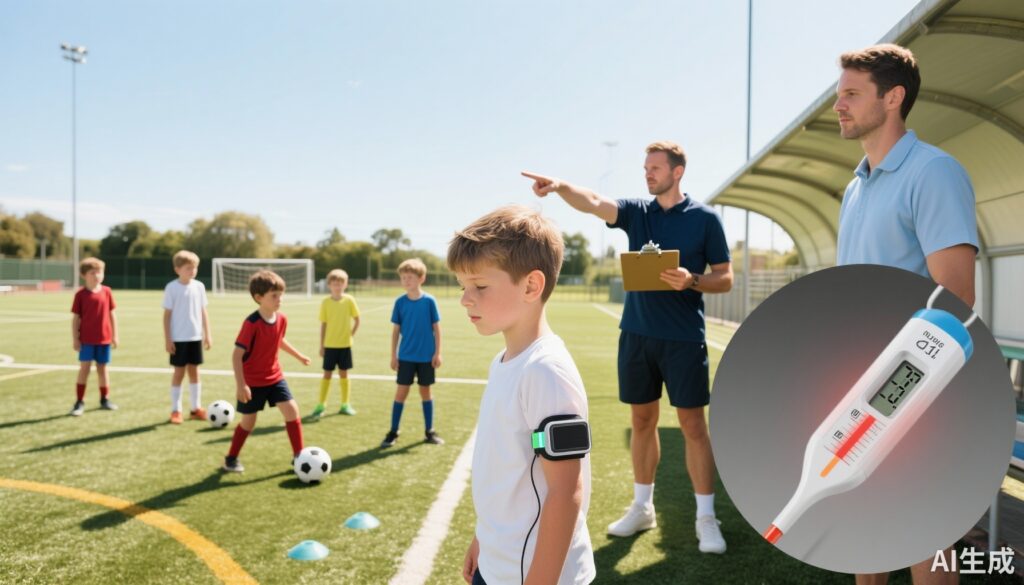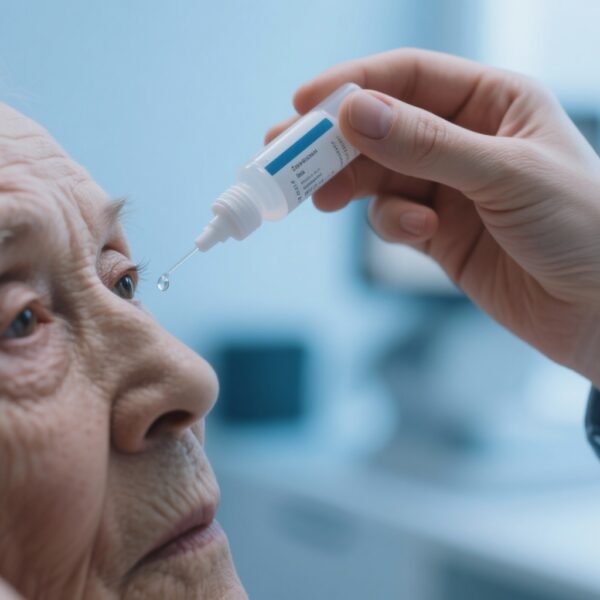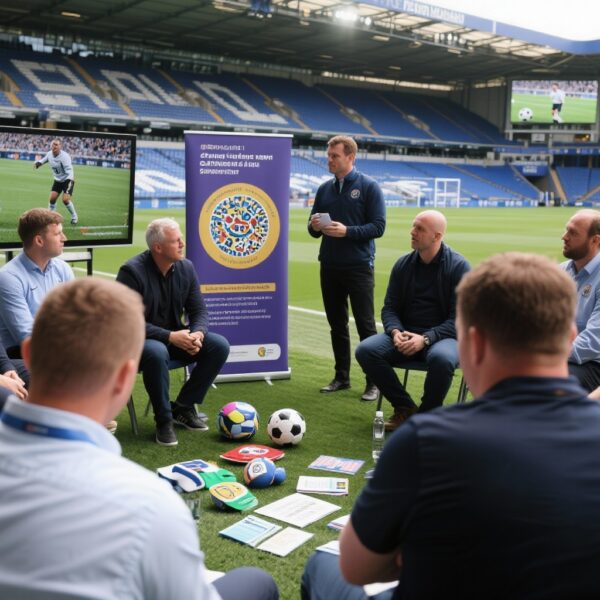Highlights
– Outdoor summer training (≥25 °C, often >32 °C) was associated with higher ear (proxy core) and skin temperatures in 8–12-year-old boys during football sessions.
– Hydration assessed by urine density did not differ with outdoor temperature in this cohort, and no severe exertional heat illness was observed.
– Short-term physiological elevations appeared clinically manageable, but limitations (male-only sample, noninvasive core-temperature proxies, brief follow-up) necessitate cautious translation and further research.
Background: Why this question matters
Rising ambient temperatures and more frequent heat waves driven by climate change pose growing risks to children who engage in outdoor sport and recreation. Children are not small adults with respect to thermoregulation: differences in body surface area, sweat rate, metabolic heat production per mass, and behavioral factors (e.g., coach-led practice structure, clothing) influence heat storage and dissipation. Organized sport participation—especially in team sports such as football (soccer)—often involves intermittent high-intensity activity that can elevate core temperature rapidly.
Health agencies and sporting organizations have developed heat-safety guidance and thresholds to modify or suspend activity, but empirical data on children’s physiologic responses in real-world training settings remain limited. The Pediatrics Society and public-health stakeholders have urged more focused study on children’s core temperature dynamics during exercise in heat, to inform school and club policies and protect pediatric athletes.
Study design
The reported study (Satow et al., 2025) used a case-crossover design to examine the acute physiological impact of outdoor heat on male children during organized football training. Key design features:
- Population: 51 male children aged 8–12 years participating either in club football (n = 30) or in a football camp (n = 21).
- Monitoring: Wearable sensors measured ear temperature (used as a surrogate for core temperature) and skin temperature. Participants were monitored twice: club players on two separate days (one warm, ≥25 °C; one moderate, <20 °C); camp participants during two sessions on the same warm summer day (both ≥25 °C).
- Hydration assessment: Urine density (urine specific gravity proxy) measured pre- and post-training.
- Analysis: Mixed linear regression models were applied separately in the club and camp settings to assess the relationship between outdoor temperature and physiologic measures.
- Outcomes: Primary physiologic outcomes were ear and skin temperature changes during training; secondary outcomes included hydration status and clinical signs of heat strain.
Key findings and interpretation
Primary physiologic responses
The study reported significantly higher ear and skin temperatures during the warm observation periods compared with moderate outdoor temperatures. In practical terms, training sessions during summer weather regularly saw ambient temperatures exceed 32.3 °C — a level noted by the study authors as one at which the American College of Sports Medicine (ACSM) advises increased caution and, in some contexts, cessation of activity. The mixed linear regression models indicated that ambient outdoor temperature was a statistically significant predictor of both ear (proxy core) and skin temperature in these cohorts.
Hydration and clinical outcomes
Despite higher thermal load, urine density measurements before and after training sessions did not differ by outdoor temperature, suggesting that acute hydration (as captured by urine concentration) was not adversely impacted in this sample. Importantly, no participant developed severe exertional heat illness or required emergent cooling; observed physiologic elevations were interpreted by the authors as significant but clinically manageable within the context of the monitored training sessions.
Contextual interpretation
These results support the biologic plausibility that higher ambient temperature acutely raises core and skin temperatures in children during football training. The absence of severe events in this modestly sized cohort does not imply absence of risk: risk of exertional heat illness depends not only on peak core temperature but also on rate of rise, duration of elevated core temperature, hydration status, acclimatization, clothing/equipment, fitness, and promptness of recognition and treatment. The findings are most directly applicable to similar populations (boys aged ~8–12 engaged in organized outdoor football) and under the specific monitoring and supervision conditions used in the study.
Expert commentary — strengths, limitations, and clinical implications
Strengths
– Real-world field monitoring during typical training sessions enhances ecological validity compared with laboratory exercise-heat studies.
– Case-crossover design (within-person comparisons when possible) reduces confounding by stable individual characteristics.
– Use of wearable sensors offers a practical approach to continuous monitoring in youth sport contexts.
Limitations
– Measurement of core temperature: Ear (tympanic) temperature is a convenient surrogate but is less accurate than rectal or esophageal measurements for true core temperature; skin temperature is influenced by local blood flow and environmental exposure.
– Sample characteristics: All participants were male and aged 8–12; findings may not generalize to girls, older adolescents, children with chronic conditions, or less active youth.
– Exposure characterization: Ambient temperature was reported, but the study did not report (or may not have fully captured) wet-bulb globe temperature (WBGT), humidity, solar load, clothing, or metabolic intensity in granular detail—factors that materially influence heat stress.
– Short-term outcomes: The study recorded acute physiologic responses but not longer-term sequelae of repeated heat exposure, heat acclimatization trajectories, or performance impacts across a season.
– Statistical detail: While the regression models showed a significant relationship between ambient temperature and physiologic measures, effect sizes, confidence intervals, and model covariates are crucial to interpret clinical relevance and were not reproduced in detail here.
Practical implications for clinicians, coaches, and schools
– Anticipate higher physiologic heat strain during warm weather training. Even if severe heat illness is uncommon with appropriate supervision, elevated core temperatures can present risk under less controlled conditions or with cumulative exposures.
– Use a layered prevention strategy: schedule practices in cooler parts of the day, provide shaded rest breaks, implement work:rest ratios adjusted for heat, ensure ready access to cool fluids, and monitor players’ perceived exertion and appearance.
– Consider objective monitoring: validated wearable sensors, periodic tympanic checks, or WBGT assessment where available. However, recognize limitations of each modality and prioritize early recognition of symptoms (dizziness, nausea, confusion, collapse).
– Maintain emergency action plans and ensure immediate access to rapid cooling (cold-water immersion or other validated methods) and trained personnel for suspected exertional heat stroke.
Research gaps and future directions
The study highlights several priorities for future research:
- Validation studies comparing ear-worn and other wearable-derived temperature measures against rectal core temperature in field settings for children.
- Inclusion of girls and broader age ranges to assess sex- and maturation-related differences in heat response.
- Longitudinal studies examining repeated training exposures across a season to understand acclimatization, cumulative strain, and performance impacts.
- Interventional trials testing schedule modifications, hydration protocols, shaded/air-conditioned recovery, and real-time monitoring thresholds to reduce heat-related adverse outcomes.
- Integration of environmental indices including WBGT, humidity, and solar radiation to refine activity-modification thresholds for youth sport.
Conclusion
Satow et al. (2025) provide field-based evidence that ambient summer temperatures are associated with higher ear and skin temperatures in 8–12-year-old boys during football training. Although no severe heat illness or hydration deficits were observed in this cohort, the findings reinforce that elevated environmental heat increases physiologic strain in children. Practitioners, coaches, and school administrators should continue to apply established heat-safety principles, adapt training plans to local conditions, and ensure monitoring and emergency preparedness. Additional well-powered, diverse, and methodologically rigorous studies are needed to define safe operational thresholds, validate wearable measures against gold-standard core-temperature methods, and evaluate long-term consequences of repeated heat exposure in youth sport.
Funding and clinicaltrials.gov
The published paper includes funding and conflict-of-interest statements; please refer to the original article for specific sponsor information. The current summary does not identify a clinicaltrials.gov registration number for this observational field study.
References
1. Satow M, Wibowo R, Bose-O’Reilly S, Koller D, Daanen H, Rakete S. Impact of summer heat on male children’s physiological responses during football training. Environ Res. 2025 Dec 1;286(Pt 1):122725. doi: 10.1016/j.envres.2025.122725. Epub 2025 Sep 2. PMID: 40907683.
2. Casa DJ, DeMartini JK, Bergeron MF, et al. National Athletic Trainers’ Association position statement: Exertional heat illnesses. J Athl Train. 2015;50(9):986–1000. doi:10.4085/1062-6050-50.9.07
3. Centers for Disease Control and Prevention. Extreme Heat and Children. Accessed 2025. https://www.cdc.gov/disasters/extremeheat/children.html
For full methodological and funding detail, readers should consult the original article by Satow et al. (2025).



